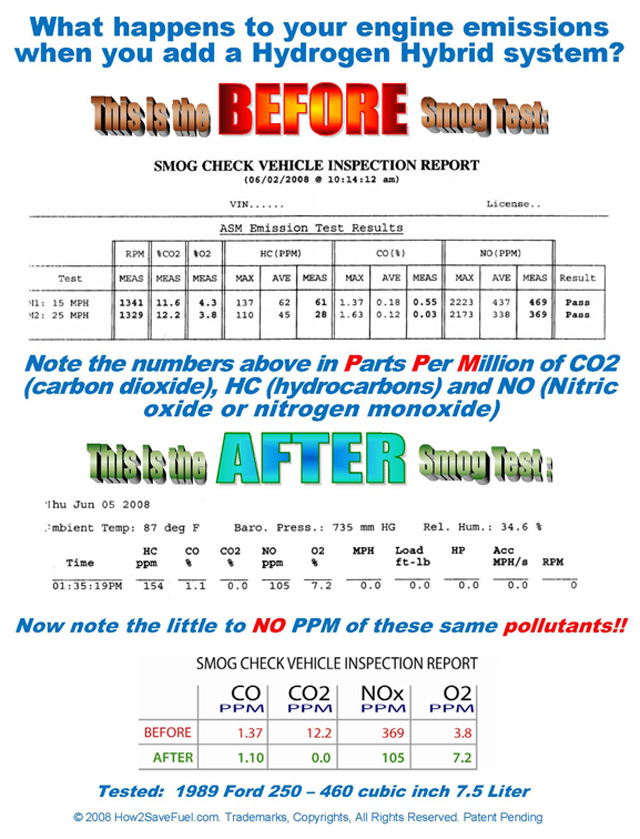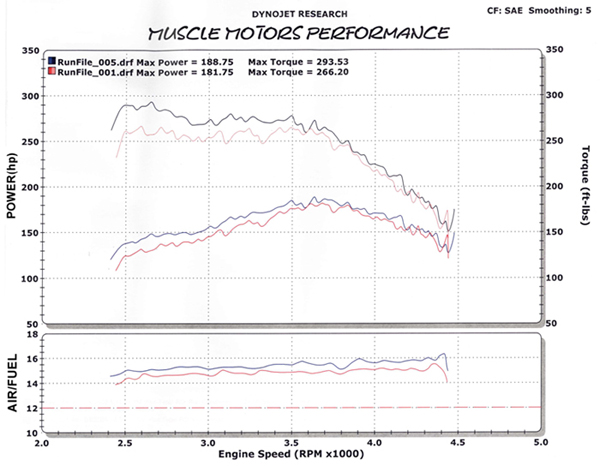|
wikipedia.org |
Hydrogen fuel enhancement
Onboard automotive
hydrogen injection systems inject either a
hydrogen-enriched mixture, or pure hydrogen into the
intake manifold of the engine. In some cases, this is
combined with air/fuel ratio and timing modifications. A
small amount of hydrogen added to the intake air-fuel
charge permits the engine to operate with leaner
air-to-fuel mixture than otherwise possible. As the
air/fuel mix approaches 30:1 the temperature of
combustion substantially decreases effectively
mitigating NOx production.
Increases
in engine efficiency are more dominant
than the energy loss incurred in
generating hydrogen.
This is specifically with
regard to use of a onboard hydrogen
reformer. Overall computational analysis
has marked the possibility of operating
with high air overabundance (lean or
ultra-lean mixtures) without a
substantial performance decrease but
with great advantages on pollution
emissions and fuel consumption. -
Read more
|
ArvinMeritor / MIT
on Nov. 2005 |
Hydrogen-Enhanced Combustion Engine Could Improve Gasoline Fuel
Economy by 20% to 30%
Work being done by ArvinMeritor, IAV (Ingenieursgesellshaft
für Auto und Verkehr) and MIT on enhancing gasoline combustion with a
small hydrogen gas stream is pointing toward a potential estimated
improvement in gasoline fuel economy of 20% to 30%, depending upon the
baseline engine. -
Read More |
Massachusetts Institute of Technology
Dept. of Mechanical Engineering |
Combustion lean limits
fundamentals and their application to a SI hydrogen-enhanced engine
concept
Operating an engine with excess air, under lean conditions, has
significant benefits in terms of increased engine efficiency and reduced
emissions. However, under high dilution levels, a lean limit is reached
where combustion becomes unstable, significantly deteriorating
drivability and engine efficiency, thus limiting the full potential of
lean combustion. Due to hydrogen's high laminar flame speed, adding a
hydrogen-rich mixture with gasoline into the engine helps stabilize
combustion, extending the lean limit. This work studies the fundamental
behavior of lean combustion in a spark ignition (SI) engine, identifying
the processes that determine the engine's efficiency curve, and studying
practical solutions to extend the peak efficiency and the lean limit.
Lean and hydrogen-enhanced combustion data in a SI engine were generated
covering a wide range of operating conditions including different
compression ratios, loads, types of dilution, types and levels of
hydrogen enhancement, and levels of turbulence. Combustion simulations
were then performed to quantify the components that determine the
efficiency vs. dilution curve. Results showed how burn duration is the
primary driver of lean combustion, with a limiting 10-90% burn duration
at peak efficiency and a limiting 0-10% burn duration at the onset of
rapid combustion variability. -
Read
more |
J. Eng. Gas Turbines Power
March 2008
Volume 130
Issue 2, 022801
|
Hydrogen-Enhanced Gasoline Stratified
Combustion in SI-DI Engines
Experimentalinvestigations were carried out to assess the
use of hydrogen in a gasoline direct injection (GDI) engine.
Injection of small amounts of hydrogen (up to 27% on energy
basis) in the intake port creates a reactive homogeneous
background for the direct injection of gasoline in the
cylinder. In this way, it is possible to operate the engine
with high exhaust gas recirculation (EGR) rates and, in
certain conditions, to delay the ignition timing as compared
to standard GDI operation, in order to reduce NO
and HC emissions to very low levels and possibly soot
emissions. The results confirmed that high EGR rates can be
achieved and NOx and HC emissions reduced, showed
significant advantage in terms of combustion efficiency and
gave unexpected results relative to the delaying of ignition, which
only partly confirmed the expected behavior. A realistic
application would make use of hydrogen-containing reformer
gas produced on board the vehicle, but safety restrictions
did not allow using carbon monoxide in the test facility.
Thus, pure hydrogen was used for a best-case investigation.
The expected difference in the use of the two gases is
briefly discussed.
-
Read more |
SAE International
April 2006 |
Predicting the Behavior of a
Hydrogen-Enhanced Lean-Burn SI Engine Concept
This paper explores the modeling of a lean boosted engine concept.
Modeling provides a useful tool for investigating different parameters
and comparing resultant emissions and fuel economy performance. An
existing architectural concept has been tailored to a boosted
hydrogen-enhanced lean-burn SI engine. The simulation consists of a set
of Matlab models, part physical and part empirical, which has been
developed to simulate a working engine. The model was calibrated with
production engine data and experimental data taken at MIT. Combustion
and emissions data come from a single cylinder research engine and
include changes in air/fuel ratio, load and speed, and different
fractions of the gasoline fuel reformed to H2 and CO. The outputs of the
model are brake specific NOx emissions and brake specific fuel
consumption maps along with cumulative NOx emissions and fuel economy
for urban and highway drive cycles. Model results closely match
production engine performance data for naturally aspirated
stoichiometric operation. Simulation of lean boosted operation with 20%
gasoline reformate fraction and 20% downsized displacement predicts a
23% improvement in fuel economy. Furthermore, part load engine-out NOx
emissions are reduced by 83% compared to a baseline naturally aspirated
stoichiometric production engine with 10% EGR dilution. |
|
Hy-Drive
Mississauga, Ontario
May 25, 2006 |
Martinrea International Exercises
Warrants Raising $1,780,000 in Equity for Hy-Drive Technologies
LTD.
Hy-Drive is an energy technology firm that has developed a proprietary,
patented hydrogen generating system. The Hy-Drive system generates and
injects hydrogen gas into a regular internal combustion engine,
enhancing the combustion process by allowing fuel to burn more
efficiently and completely. In previous extensive customer trials and
tests, the Hy-Drive system has demonstrated significant performance
enhancements, including reduced emissions, increased torque/horsepower,
fuel savings and extended engine life. These benefits, specifically fuel
economy and reduced emissions, provide customers with greater
productivity overall, as their engines operate more efficiently, with
improved cycle times and less carbon build-up. For further information,
visit www.hy-drive.com. |
MTZ worldwide Edition
No.: 2005-10 |
Hydrogen-Enhanced Combustion - A
Promising Concept for Ultra-lean Homogeneous Combustion
Ultra-lean-burn combustion is viewed by many as a necessary next
significant step in the evolution of the gasoline engine. However,
emission constraints require that these engines operate under
stoichiometric conditions to avoid costly emissions control solutions.
The addition of small amounts of hydrogen to the cylinder charge can
allow these types of engines to operate much leaner than they otherwise
could, eliminating the need to treat NOx emissions altogether. While
this is not a new idea, it is Arvin-Meritor's development of a compact
and fast-response fuel reformer that is bringing this concept much
closer to reality. -
Read more |
|
The National Energy Technology
Laboratory (NETL), part of DOE’s national laboratory system, is owned
and operated by the U.S. Department of Energy (DOE). |
IEP
- Advanced NOx Emissions Control
Control Technology - O2
Enhanced Combustion
Oxygen-fired combustion has been utilized in industrial furnaces to
improve energy efficiency and reduce emissions. NOx emissions reductions
of as much as 80-90% have been demonstrated at commercial glass melting
furnaces that have been converted to oxy-fuel firing. One of the
required keys to successfully implementing oxygen-fired or enhanced
combustion is an economical source of oxygen, which also can benefit
numerous other technologies. Praxair is developing a novel oxygen
separation technology at its Tonawanda, New York facility, using an
Oxygen Transport Membrane (OTM). Ceramic membranes are attractive since
they can have virtually infinite selectivity for oxygen, thereby
allowing only the oxygen to pass through. There are two basic types of
ceramic membranes, pressure and electrically driven. This project will
use pressure as the driving force for separation. |
|
The World Intellectual Property
Organization (WIPO) |
HIGH COMPRESSION RATIO, HYDROGEN
ENHANCED GASOLINE ENGINE SYSTEM
High Compression Ratio, Hydrogen Enhanced Gasoline Engine System
Background of the Invention This invention relates to an engine system
and more particularly to a gasoline engine system employing hydrogen
enhanced operation.
Hydrogen addition can be
used to reduce pollution (especially NOx) from vehicles with spark
ignition engines using gasoline and other fuels. Hydrogen can be
produced by onboard conversion of a fraction of gasoline or other
primary fuel into hydrogen rich gas (H2 + CO) by partial oxidation in
compact onboard devices suitable for vehicle applications. -
Read more |
Energy Tech
October 2003
|
A plasmatron is a device
that can convert gasoline and diesel fuel into hydrogen.
Hydrogen can be used in diesel engines to reduce nitrogen
oxides (NOx) emission.
The researchers and colleagues
from industry report that the plasmatron, used with an
exhaust treatment catalyst on a diesel engine bus, removed
up to 90 percent of nitrogen oxides (NOx) from the bus’s
emissions. Nitrogen oxides are the primary components of
smog.
The plasmatron reformer
also cut in half the amount of fuel needed for the removal
process. “The absorption catalyst approach under
consideration for diesel exhaust NOx removal requires
additional fuel to work,” explained Daniel R. Cohn, one of
the leaders of the team and head of the Plasma Technology
Division at MIT's Plasma Science and Fusion Center (PSFC).
“The plasmatron reformer reduced that amount of fuel by a
factor of two compared to a system without the plasmatron.”
In gasoline engines the use
of plasmatrons will boost car fuel efficiency by 20 percent.
"If widespread use
of plasmatron hydrogen-enhanced gasoline engines could
eventually increase the average efficiency of cars and
other light-duty vehicles by 20 percent, the amount
of gasoline that could be saved would be around 25
billion gallons a year," Cohn said. "That corresponds to
around 70 percent of the oil that is currently imported
by the United States from the Middle East."
The Bush administration has
made development of a hydrogen-powered vehicle a priority,
Heywood noted. "That's an important goal, as it could lead
to more efficient, cleaner vehicles, but is it the only way
to get there? Engines using plasmatron reformer technology
could have a comparable impact, but in a much shorter time
frame," he said. -
Read more
|
|
California Environmental Engineering (CEE) |
California Environmental Engineering (CEE) has tested this technology
and found reduction on all exhaust emissions. They subsequently stated:
“CEE feels that the result of this test verifies that this technology is
a viable source for reducing emissions and fuel consumption on large
diesel engines.” |
|
The American Hydrogen Association Test Lab |
The American Hydrogen Association Test Lab tested this technology and
proved that: “Emissions test results indicate that a decrease of toxic
emissions was realized.” Again, zero emissions were observed on CO
(carbon). |
|
Corrections Canada |
Corrections Canada tested several systems and concluded, “The hydrogen
system is a valuable tool in helping Corrections Canada meet the overall
Green Plan by: reducing vehicle emissions down to an acceptable level
and meeting the stringent emissions standard set out by California and
British Columbia; and reducing the amount of fuel consumed by increased
mileage.”
Additionally, their analysis pointed out that this solution is the most
cost effective. For their research they granted the C.S.C. Environmental
Award. |
|
. |
|

